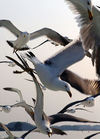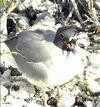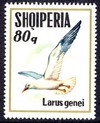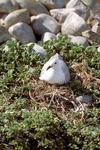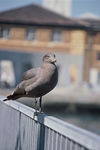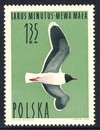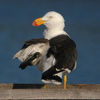Genus Larus

European herring gull - The taxonomy of the Herring Gull / Lesser Black-backed Gull complex is very complicated, different authorities recognising between two and eight species.
Armenian Gull - Armenian Gulls are similar to Yellow-legged Gulls but are slightly smaller with a slightly darker grey back and dark eyes. The area of black on the wingtips is more extensive with smaller white spots. The bill is short with a distinctive black band just before the tip. First-winter birds are mainly brown. They have a whitish rump, pale inner primary feathers and a narrow, sharply-defined black band on the tail.
Olrog's Gull - It is threatened by habitat loss.
Laughing Gull - The Laughing Gull, Leucophaeus atricilla, is a medium-sized gull of North and South America. It breeds on the Atlantic coast of North America, the Caribbean, and northern South America. Northernmost populations migrate further south in winter, and this species occurs as a rare vagrant to western Europe. The Laughing Gull's English name is derived from its raucous kee-agh call, which sounds like a high-pitched laugh "ha... ha... ha..".
Audouin's Gull - The Audouin's Gull is a large gull restricted to the Mediterranean and the western coast of Saharan Africa. It breeds on small islands colonially or alone, laying 2-3 eggs on a ground nest. As is the case with many gulls, it has traditionally been placed in the genus Larus.
Band-tailed gull - The name of this bird commemorates the British explorer Sir Edward Belcher.
Brown-headed Gull - The Brown-headed Gull, Chroicocephalus brunnicephalus, is a small gull which breeds in the high plateaux of central Asia from Turkmenistan to Mongolia. It is migratory, wintering on the coasts and large inland lakes of tropical southern Asia. As is the case with many gulls, it has traditionally been placed in the genus Larus.
Black-billed Gull - The Black-billed Gull is a species of gull in the Laridae family. It is endemic to New Zealand. As is the case with many gulls, it has traditionally been placed in the genus Larus, but is now considered to be the genus Chroicocephalus.
Caspian gull - It is a large gull with a long, slender bill, accentuated by the sloping forehead. The legs, wings and neck are longer than those of the Herring Gull and Yellow-legged Gull. The eye is small and often dark, the legs vary from pale pink to a pale yellowish colour. The back and wings are a slightly darker shade of grey than the Herring Gull but slightly paler than the Yellow-legged Gull. The outermost primary feather has a large white tip and a white tongue running up the inner web.
California Gull - Adults are similar in appearance to the Herring Gull, but have a smaller yellow bill with a black ring, yellow legs, brown eyes and a more rounded head. The body is mainly white with grey back and upper wings. They have black primaries with white tips. Immature birds are also similar in appearance to immature Herring Gulls, with browner plumage than immature Ring-billed Gulls.
Mew Gull - Adults are 40-46 cm long, obviously smaller than the Herring Gull, and slightly smaller than the Ring-billed Gull, also differing from this in its shorter, more tapered bill with a more greenish shade of yellow, as well as being unmarked during the breeding season. The body is grey above and white below. The legs are greenish-yellow. In winter, the head is streaked grey, and the bill often has a poorly-defined blackish band near the tip . They have black wingtips with large white "mirrors". Young birds have scaly black-brown upperparts and a neat wing pattern, and grey legs. They take two to three years to reach maturity. The call is a high-pitched "laughing" cry.
Grey-hooded gull - The Grey-headed Gull is a small gull which breeds patchily in South America and Africa south of the Sahara. It is not truly migratory, but is more widespread in winter. This species has occurred as a rare vagrant to North America and Spain. It is known as the Gray-hooded Gull by the American Ornithologists' Union. As is the case with many gulls, it has traditionally been placed in the genus Larus.
Black-tailed Gull - It has yellow legs and a red and black spot at the end of the bill. This gull takes 4 years to reach full adult plumage. As the name suggests, it has a black tail. The bird has a cat-like call, giving it its Japanese name — Umineko, "Sea cat" and Korean name — Gwaeng-yi gull, which means "cat" gull.
Ring-billed Gull - Adults are 49 cm length and with a 124 cm wingspan. The head, neck and underparts are white; the relatively short bill is yellow with a dark ring; the back and wings are silver gray; and the legs are yellow. The eyes are yellow with red rims. This gull takes three years to reach its breeding plumage; its appearance changes with each fall moult.
Kelp Gull - The African subspecies L. d. vetula is sometimes split as the Cape Gull, L. vetula. It has a more angular head and a smaller shorter bill. The adult has a dark eye, whereas the nominate Kelp Gull usually has a pale eye. Young Cape Gulls have almost identical plumage to similarly aged Kelp Gulls.
Lava Gull - The Lava Gull is a large gull. One of the rarest gulls in the world, the entire population lives on the Galapagos Islands and is estimated at 400 pairs.
Lesser Black-backed Gull - This species breeds colonially on coasts and lakes, making a lined nest on the ground or cliff. Normally, three eggs are laid. In some cities the species nests within the urban environment, often in association with Herring Gulls.
Slender-billed Gull - The Slender-billed Gull, Chroicocephalus genei, is a mid-sized gull which breeds very locally around the Mediterranean and the north of the western Indian Ocean on islands and coastal lagoons. Most of the population is somewhat migratory, wintering further south to north Africa and India, and a few birds have wandered to western Europe. A stray individual was reportedly seen on Antigua, April 24, 1976 .
Glaucous-winged gull - The Glaucous-winged Gull is rarely found far from saltwater. It is a large bird, measuring 24 to 27 in. with a white head, neck, breast, and belly, a white tail, and pearly-gray wings and back. The term glaucous describes its colouration. The ends of its wings are white-tipped. Its legs are pink and the beak is yellow with a red subterminal spot. The forehead is somewhat flat. During the winter, the head and nape appears dusky, and the subterminal spot becomes dark. Young birds are brown or gray with black beaks, and take four years to reach full plumage.
Iceland Gull - The Iceland Gull, Larus glaucoides, is a large gull which breeds in the Arctic regions of Canada and Greenland, but not Iceland, where it is only seen in the winter. It is migratory, wintering from in the North Atlantic as far south as the British Isles and northernmost states of the eastern USA, as well as in the interior of North America as far W as the western Great Lakes. It is much scarcer in Europe than the similar Glaucous Gull.
Hartlaub - The Hartlaub's Gull or King Gull, is a small gull, which is a non-migratory breeding resident endemic to the Atlantic Ocean coastline of South Africa and Namibia. Although it is predominantly coastal or estuarine, it is not a pelagic species, and is rarely seen at sea far from land. It was formerly sometimes considered to be a subspecies of the Silver Gull , and, as is the case with many gulls, it has traditionally been placed in the genus Larus but is now placed in the genus Chroicocephalus.
Heermann's gull - This species looks distinctly different from other gulls. Adults have a medium gray body, blackish-gray wings and tail with white edges, and a red bill with a black tip. The head is dusky gray in non-breeding plumage and white in breeding plumage. Immatures resemble non-breeding adults but are darker and browner, and the bill is flesh-colored or pink till the second winter. A few birds, no more than 1 in 200, have white primary coverts, which form a showy spot on the upper wing.
Sooty Gull - The Sooty Gull is a species of gull in the Laridae family. It is found in Bahrain, Djibouti, Egypt, Eritrea, Iran, Israel, Jordan, Kenya, Lebanon, Maldives, Mozambique, Oman, Pakistan, Qatar, Republic of India, Saudi Arabia, Somalia, Sri Lanka, Sudan, Tanzania, United Arab Emirates, and Yemen. As is the case with many gulls, it has traditionally been placed in the genus Larus.
Glaucous Gull - This species breeds colonially or singly on coasts and cliffs, making a lined nest on the ground or cliff. Normally, 2–4 light brown eggs with dark chocolate splotches are laid.
Great Black-headed Gull - The Great Black-headed Gull or Pallas's Gull, Ichthyaetus ichthyaetus, is a large gull. As is the case with many gulls, it has traditionally been placed in the genus Larus.
White-eyed Gull - The White-eyed Gull is a small gull which is endemic to the Red Sea. Its closest relative is the Sooty Gull. It is one of the world's rarest gulls, with a population of just 4,000 - 6,500 pairs. The species is classed as Near Threatened by the IUCN; human pressure and oil pollution are deemed the major threats. As is the case with many gulls, it has traditionally been placed in the genus Larus.
Yellow-footed gull - Adults are similar in appearance to the Western Gull with a white head, dark, slate-colored back and wings, and a thick yellow bill. Its legs are yellow, though first winter birds do display pink legs like those of the Western Gull. It attains full plumage at three years of age. The gull measures 21-23 inches .
Brown-hooded Gull - The Brown-hooded Gull is a species of gull in the Laridae family. As is the case with many gulls, it has traditionally been placed in the genus Larus.
Great Black-backed Gull - The Great Black-backed Gull was one of the many species originally described by Linnaeus in his 18th-century work, Systema Naturae, and it still bears its original name of Larus marinus.
Mediterranean Gull - The Mediterranean Gull, Ichthyaetus melanocephalus, is a small gull which breeds almost entirely in Europe, mainly in the south east, especially around the Black Sea, and in central Turkey. There are colonies elsewhere in southern Europe, and this species has undergone a dramatic range expansion in recent decades. Birders often abbreviate its name to "Med Gull". As is the case with many gulls, it has traditionally been placed in the genus Larus.
Little Gull - The Little Gull is a small gull which breeds in northern Europe and Asia. It also has small colonies in parts of northern Canada. It is migratory, wintering on coasts in western Europe, the Mediterranean and the northeast USA. As is the case with many gulls, it has traditionally been placed in the genus Larus. It is the only member of the genus Hydrocoloeus, although it has been suggested that Ross's Gull also should be included in this genus.
Gray Gull - This article is about the bird. For the record label, see Grey Gull Records.
Silver Gull - The Silver Gull also known simply as "seagull" in Australia, is the most common gull seen in Australia. It has been found throughout the continent, but particularly coastal areas. The South African Hartlaub's Gull and the New Zealand Red-billed Gull were formerly sometimes considered to be subspecies of the Silver Gull. As is the case with many gulls, it has traditionally been placed in the genus Larus but is now placed in the genus Chroicocephalus.
Western Gull - The Western Gull is a large gull, around 60 cm long with a white head and body, and gray wings. It has a yellow bill with a red subterminal spot . It closely resembles the Slaty-backed Gull . In the north of its range it forms a hybrid zone with its close relative the Glaucous-winged Gull .
Pacific Gull - Much larger than the ubiquitous Silver Gull, and nowhere near as common, Pacific Gulls are usually seen alone or in pairs, loafing around the shoreline, steadily patrolling high above the edge of the water, or zooming high on the breeze to drop a shellfish or sea urchin onto rocks.
Bonaparte's Gull - The Bonaparte's Gull is a small gull.
Franklin's Gull - The Franklin's Gull is a small gull. It breeds in central provinces of Canada and adjacent states of the northern USA. It is migratory, wintering in the Caribbean, Peru, Chile, and Argentina.
Relict gull - The Relict Gull, Ichthyaetus relictus, is a medium-sized gull which breeds in several locations in Mongolia , two in Kazakhstan, one in Russia, and one in China. Small numbers appear to migrate to South Korea during the nonbreeding period. There is additional evidence that larger numbers may migrate to eastern China as well, but this is not verified. As is the case with many gulls, it has traditionally been placed in the genus Larus.
Common black-headed gull - The Black-headed Gull is a small gull which breeds in much of Europe and Asia, and also in coastal eastern Canada. Most of the population is migratory, wintering further south, but some birds in the milder westernmost areas of Europe are resident. Some birds will also spend the winter in northeastern North America, where it was formerly known as the Common Black-headed Gull. As is the case with many gulls, it was previously been placed in the genus Larus.
Saunders's Gull - The Saunders' Gull is named after British ornithologist, Howard Saunders.
Slaty-backed Gull - The Slaty-backed Gull is a very large gull at 27 inches long. It has a white head, belly, and tail with a dark slaty-gray back and wings with a broad white trailing edge. The wings and back are slightly darker than those of the Western Gull. The underside of the wings features a "string of pearls" pattern along their edges; these can be seen from below when the bird is in flight. Its eyes are yellow. The legs are pink and short when compared with those of similar-looking gulls, and the body appears more stout. The bill is yellow with orange-red subterminal spot. Immature gulls' plumage is brown, similar to the that of the Great Black-backed Gull, but paler, and is practically indistinguishable from the immature Herring Gull in the field.
Red-billed Gull - The Red-billed Gull , once also known as the Mackerel Gull, is a native of New Zealand, being found throughout the country and on outlying islands including the Chatham Islands and Sub-antarctic islands.The Māori name of this species is Tarapunga or Akiaki. Its vernacular name is sometimes also used for the Dolphin Gull, a somewhat similar-looking but unrelated species. As is the case with many gulls, the Red-billed Gull has traditionally been placed in the genus Larus.
Andean Gull - The Andean Gull is a species of gull in the Laridae family. As is the case with many gulls, it has traditionally been placed in the genus Larus. It is found in Argentina, Bolivia, Chile, Colombia, Ecuador, and Peru. Its natural habitats are rivers, freshwater lakes, saline marshes, and pastureland.
Thayer's Gull - The Thayer's Gull is a large gull native to North America that breeds in the Arctic islands of Canada and primarily winters on the Pacific coast, from southern Alaska to the Gulf of California, though there are also wintering populations on the Great Lakes and the upper Mississippi River. The species has occurred a vagrant to Tamaulipas, Mexico 1, Japan 3., Denmark, and other parts of western Europe.












